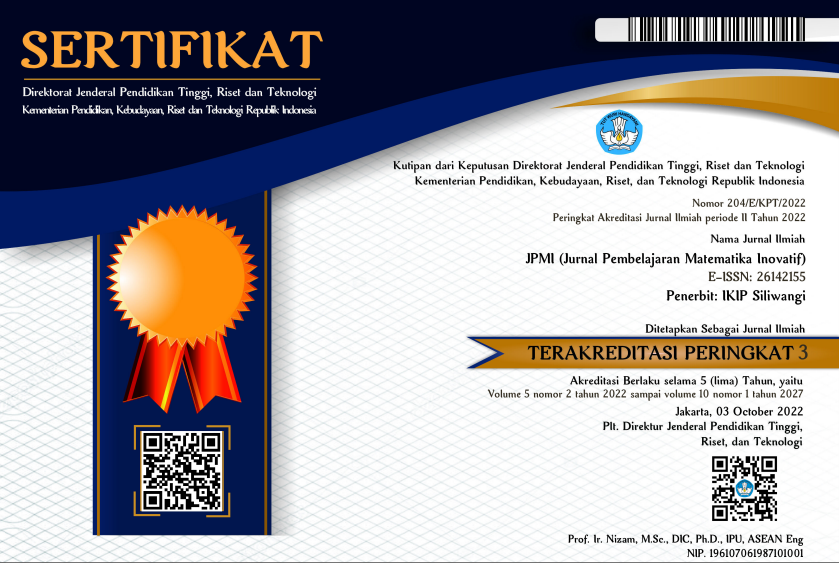Penerapan pembelajaran "two stay-two stray" dengan pendekatan kontekstual terhadap pemahaman matematika siswa kelas XII
DOI:
https://doi.org/10.22460/jpmi.v7i1.18635Kata Kunci:
Two Stay- Two Stray, Contextual Learning, Understanding AbilitiesAbstrak
This study employs a quasi-experimental approach, utilizing a posttest-only control group design, to investigate the applicability of implementing "two stay-two stray" learning with a contextual approach to enhance the mathematical understanding of class XII students at SMK Negeri 1 Cimahi. The participants in this research consist of class XII students, totaling 34 students each, distributed into control and experimental groups, each subjected to different teaching methods. The research utilized a mathematical understanding ability test as the instrument, with subsequent data analysis carried out using the SPSS Statistics software. The data analysis reveals significant differences in mathematical understanding abilities between students who underwent "two stay-two stray" learning and those who were taught using conventional methods. The t-test yielded an average score of 81.02 with a significance level > 0.05, indicating normal data distribution.
Referensi
Ahmad, K. A., Ishak, & Afdalla. (2022). Peningkatkan hasil belajar matematika melalui model pembelajaran kooperatif Tipe Two Stay Two Stray. Visipena Journal, 2(1), 21–27. https://doi.org/10.46244/visipena.v2i1.36
Alzanatul Umam, M., & Zulkarnaen, R. (2022). Analisis kemampuan pemahaman konsep matematis siswa dalam materi sistem persamaan linear dua variabel. Jurnal Educatio FKIP UNMA, 8(1), 303–312. https://doi.org/10.31949/educatio.v8i1.1993
Apriyani, Ratna Aripin, U. (2022). Scientific approach effect on mathematical communication ability of junior high school students. (JIML) Journal of Innovative Mathematics, 5(2), 68–74. https://doi.org/https://dx.doi.org/10.22460/jiml.v5i2.p68-74
Bunga Adetya Rachmawati, Purwanto, S., & Sari, P. (2020). Pengaruh model pembelajaran kooperatif tipe Two Stay Two Stray (TSTS) dengan pendekatan kontekstual terhadap kemampuan pemahaman konsep matematis siswa SMP Negeri 169 Jakarta. Jurnal Riset Pendidikan Matematika Jakarta, 2(2), 59–70. https://doi.org/10.21009/jrpmj.v2i1.14859
Chairunnisa Inayatusufi, Hakim, L. El, & Sari, P. (2020). Peningkatan kemampuan pemahaman konsep matematis melalui model kooperatif tipe scramble dengan pendekatan kontekstual pada materi segiempat dan segitiga di kelas VII. Jurnal Riset Pendidikan Matematika Jakarta, 2(2), 28–37. https://doi.org/10.21009/jrpmj.v2i1.15118
Dini, M., Nuraeni, N., & Anita, I. W. (2018). Meningkatkan kemampuan pemahaman matematis siswa SMK menggunakan pendekatan kontekstual pada materi SPLTV. IndoMath: Indonesia Mathematics Education, 1(1), 49. https://doi.org/10.30738/indomath.v1i1.2218
Hendriana, H., Eti, E., & Sumarmo, U. (2017). Hard Skills dan Soft Skills Matematik Siswa.
Hidayat, P. A., & Nuraeni, R. (2022). Kemampuan pemahaman matematis siswa smp pada materi perpangkatan dan bentuk akar secara daring pada masa pandemi covid-19 di desa jayaraga. Jurnal Inovasi Pembelajaran Matematika: PowerMathEdu, 1(2), 183–192. https://doi.org/10.31980/powermathedu.v1i2.2230
Malinda, V., & Setiawan, W. (2022). Implementasi problem based learning terhadap hasil belajar matematik siswa SMK Kelas XI. JPMI (Jurnal Pembelajaran …, 5(3), 703–710. https://doi.org/10.22460/jpmi.v5i3.703-710
Purnama, A. E., Usodo, B., & Kuswardi, Y. (2018). Eksperimentasi model pembelajaran TSTS berbasis pendekatan kontekstual pada materi trigonometri ditinjau dari keaktifan belajar siswa. Jurnal Pendidikan Matematika Dan Matematika (JPMM) Solusi, 2(2), 127–133.
Ramadhana, R. S. A., & Pulungan, S. A. (2021). Pengembangan lebar kerja siswa berbasis kontekstual untuk meningkatkan kemampuan penalaran matematis siswa SMKS Al-Bukhary Rantauprapat. Al-Khawarizmi …, 2(2). https://ejurnal.univalabuhanbatu.ac.id/index.php/alkhawarizmi/article/view/529%0Ahttps://ejurnal.univalabuhanbatu.ac.id/index.php/al-khawarizmi/article/download/529/368
Rambe, A. Y. F., & Afri, L. D. (2020). Analisis kemampuan pemecahan masalah matematis siswa dalam menyelesaikan soal materi barisan dan deret. AXIOM : Jurnal Pendidikan Dan Matematika, 9(2), 175. https://doi.org/10.30821/axiom.v9i2.8069
Sofianti, F., & Afrilianto, M. (2021). Penerapan pendekatan saintifik untuk menumbuhkan kemandirian belajar pada siswa SMK kelas XI. JPMI : Jurnal Pembelajaran Matematika Inovatif, 4(3), 667–674. https://doi.org/10.22460/jpmi.v4i3.667-674
Sugandi, A. I., & Benard, M. (2018). Penerapan pendekatan kontekstual terhadap kemampuan pemahaman dan komunikasi matematis siswa SMP. 4(1), 16–23. https://doi.org/https://doi.org/10.15575/ja.v4i1.2364
Trisnawati, N. F. (2017). Efektivitas model pembelajaran kooperatif tipe Two Stay Two Stray dengan pendekatan saintifik dalam pembelajaran matematika pada siswa SMP Negeri 2 kota Sorong. Median : Jurnal Ilmu Ilmu Eksakta, 9(3), 36–42. https://doi.org/10.33506/md.v9i3.15
Unaizatin, S. (2023). Upaya meningkatkan aktivitas dan hasil belajar matematika dengan menggunakan model pembelajaran kooperatif tipe dua tinggal dua tamu (Two Stay Two Stray) di Kelas XI TKJ 2 SMK Negeri 6 Malang. 05(04), 15030–15037. https://doi.org/https://doi.org/10.31004/joe.v5i4.2558
Yanti, R., Laswadi, L., Ningsih, F., Putra, A., & Ulandari, N. (2019). Penerapan pendekatan saintifik berbantuan geogebra dalam upaya meningkatkan pemahaman konsep matematis siswa. AKSIOMA : Jurnal Matematika Dan Pendidikan Matematika, 10(2), 180–194. https://doi.org/10.26877/aks.v10i2.4399
Yunus, N. A., Hulukati, E., & Djakaria, I. (2019). Pengaruh pendekatan kontekstual terhadap kemampuan penalaran matematis ditinjau dari gaya kognitif peserta didik. Jambura Journal of Mathematics, 2(1), 30–38. https://doi.org/10.34312/jjom.v2i1.2591
Zakiah, N. E., Sunaryo, Y., & Amam, A. (2019). Implementasi pendekatan kontekstual pada model pembelajaran berbasis masalah berdasarkan langkah-langkah polya. Teorema: Teori Dan Riset Matematika, 4(2), 111. https://doi.org/10.25157/teorema.v4i2.2706
Unduhan
Diterbitkan
Terbitan
Bagian
Lisensi
Hak Cipta (c) 2024 JPMI (Jurnal Pembelajaran Matematika Inovatif)

Artikel ini berlisensiCreative Commons Attribution-ShareAlike 4.0 International License.
The author is responsible for acquiring the permission(s) to reproduce any copyrighted figures, tables, data, or text that are being used in the submitted paper. Authors should note that text quotations of more than 250 words from a published or copyrighted work will require grant of permission from the original publisher to reprint. The written permission letter(s) must be submitted together with the manuscript.
















